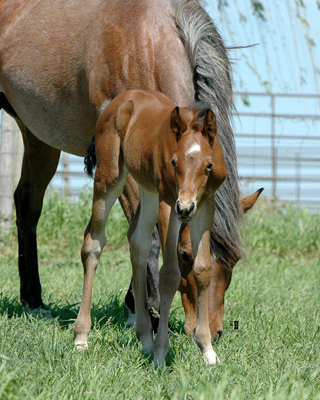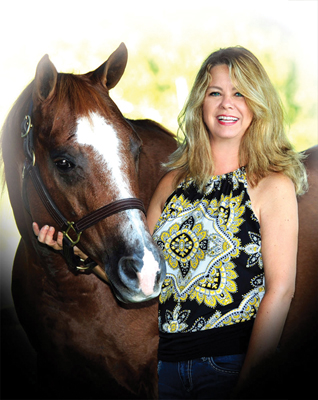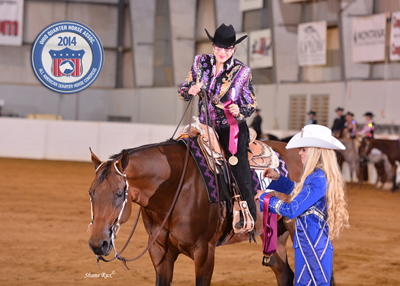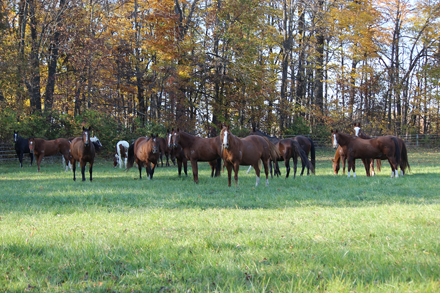 Serious breeders today are taking a more scientific approach to the process than the old days of hauling your mare to a stallion owner’s farm and leaving her there until she is bred. Whether a large breeding operation, or a small family farm, breeders are making educated, analytical decisions when it comes to selecting stallions for their mares, each looking for the very best foal they can raise. The first step for all of them seems to be evaluating their mares first, then finding the stallions that will give them the best shot at producing that World Champion of all our dreams.
Serious breeders today are taking a more scientific approach to the process than the old days of hauling your mare to a stallion owner’s farm and leaving her there until she is bred. Whether a large breeding operation, or a small family farm, breeders are making educated, analytical decisions when it comes to selecting stallions for their mares, each looking for the very best foal they can raise. The first step for all of them seems to be evaluating their mares first, then finding the stallions that will give them the best shot at producing that World Champion of all our dreams.
Gumz Farms, in Morganfield, Kentucky, owns 22 broodmares and stands six stallions. The farm is very full with a combination of recipient mares, client mares and farm mares for the full-time breeding operation, plus weanlings and yearlings. Gumz stands five outside
performance stallions, along with their young stallion, Its A Southern Thing. “Our numbers fluctuate greatly throughout the year,” says Amy Gumz, “but we have a capacity of 300.”
In addition to making breeding choices for her own mares and stallion, Amy offers her expertise to mare owners in selecting stallions for their mares. Gumz begins with the mare. “When selecting a sire for a mare, I am very critical of her. First is her movement andconformation. It’s unfair to expect a stallion to fix everything, but we try to find one that will breed out her shortcomings. For example, I find shortening a mare’s back to be a difficult trait to breed out, so I would choose a stallion that has and is known to pass on a shorter back.”
“I also consider that mare’s movement and mind, again being critical to identify any weak areas. Genetic testing has thrown a new wrench into the mix. I don’t rule out mares or stallions with a positive test, but I make sure that I’m not breeding two animals that both have a positive or carrier status. I personally don’t breed for color.”
With a short window between foaling and rebreeding, sometimes decisions on stallions must be made quickly.

Amy Gumz
“If I was secure in my initial breeding decision, I repeat the cross two or three times. If I really dislike the cross, then I will change after that first foal. It takes three to four years to see how that cross (foal) will ride and show in the pleasure events, so extra time is needed,” explains Gumz. “Sometimes stallions become unavailable or a much better cross becomes apparent that will also cause me to make a change sooner.”
Adria Smith owns the Hunter Under Saddle stallion, These Irons Are Hot, one of the stallions that stands at Gumz Farms. In addition to owning the stallion, Smith owns a couple of mares and has purchased a couple of embryos from proven mares to breed to her stallion as well. Except for a daughter of These Irons Are Hot, Smith selects mares to breed only to her stallion.
As a small breeder, she places her priorities in quality over quantity. “I try to only buy proven mares, but occasionally a high quality mare becomes available and I will gamble on her,” says Smith. “I usually look for a strong show record and produce record on the mares. Then I consider their movement, conformation and size. My stallion is quite tall so I don’t want mares that are too big.”
Smith’s mares live and foal at Gumz Farms so she doesn’t get to see them much other than photos and videos from Amy.
“I depend on her input to help me make breeding decisions,” she says. “Traditionally, we continue to breed the mare the same way, unless that foal shows us that the cross is not going to be a strong one. Especially with Hunter Under Saddle horses, that may take several years before we see the foal actually performing to see the result.”
If the cross does not produce the foal with the qualities Smith and Gumz want to see in the offspring of These Irons Are Hot, the decision will be made to replace that mare for Smith.
The Voss family, of New Liberty, Iowa, has built a successful boutique breeding business of pleasure horses with Delitas Good Version, a daughter of Good Version, as the cornerstone. A daughter of hers and two roan Good Bar bred mares round out their small broodmare band. “I have found that three broodmares is all we care to handle. And since (daughter) Jill only has one butt, we don’t need more prospects to ride,” says Sue Voss, with a laugh.
Delitas Good Version has produced eight foals, all sired by One Hot Krymsun.
“They have been a study in statistics,” says Voss. Fifty percent have been fillies, who have all been bay. The colts have ranged in color from sorrel to brown to black. All but the two 2-year- olds have been point earners, including One Hot Drama Mama, 2014 AQHA World Champion Trail, multiple Superior and AQHA High Point horse. The six foals shown have earned 1,447 AQHA points and over $28,785 in NSBA earnings, with both of those totals sure to continue climbing.
The first foal by One Hot Krymsun and Delitas Good Version was the mare Hot Conversation, who is now one of their broodmares.
“We actually conducted a scientific experiment,” explains Voss. “Shortly after we purchased Delitas Good Version, we had an opportunity to purchase her full sister, Delitas Sweet Susan. We kept Delitas Good Version as our control mare, breeding her exclusively to One Hot Krymsun, but bred her full sister to other stallions, including One Hot Krymsun.”
Unfortunately, that mare died in 2011, but they have a 2010 mare by Coats N Tails being shown now.
“I really like that mare,” said Sue.
“We will most likely conduct the same type of experiment with the two roan mares, since they are so closely related,” explains Voss. One is a daughter of Zippos Mr Good Bar and the other is a daughter of Frosty The Goodbar, by Zippos Mr Good Bar.
“We’ll plan to stick to one bloodline with one of them, but experiment some with the other,” she explains.
One is bred to One Hot Krymsun and the other to a son of One Hot Krymsun and Delitas Good Version, expecting foals this year.
“We actually did two embryo transfers with Delitas Good Version and One Hot Krymsun, and have two 2-year- olds from that breeding,” Voss adds. “I would love to repeat the embryo transfer process with her again, but we have had no success on a rebreed so she has retired from the breeding and I actually plan to show her again this year.”

Sue Voss & Krymsun Kowgirl
Voss says she believes in keeping her breeding program young. She follows advice her late husband, Richard, received years ago from one of his animal science professors – “Don’t fall in love with old bulls.”
“I think more people should ‘repurpose’ their broodmares and keep their breeding programs young. There are so many people out there that would love to have an older horse that is bombproof with a show record, especially for novices and youth,” says Voss. “So, I don’t really have too many qualms about retiring Delitas Good Version from the breeding, especially since we still have two of her daughters – and I like riding her.”
“I also believe in young stallions. I believe One Hot Krymsun was just 3 years old when we first bred to him, and Delitas Good Version was 5. She’s 18 now.”
That original choice of One Hot Krymsun as a sire was not made lightly. Sue spent hours studying pedigrees. Daughter Jill had pointed out One Hot Krymsun’s video of him winning the 2-Year-Old Western Pleasure at the (AQHA) World Show and they loved how he moved.
“When I began to look at his pedigree, I realized that this would be the perfect three-way cross,” she explains. “With One Hot Krymsun, you have the great bloodlines of Barpasser (through Invitation Only) and Doc Bar (through Hotrodders Jet Set) coming through. With Delitas Good Version (by Good Version out of a Levi Zipper mare), she was actually line bred Zippo Pine Bar. Of course, everything goes back to Three Bars it seems, but that’s another piece of advice I got from Richard – “Everything farther back than four generations is insignificant and contributes virtually nothing,” so I follow that. I find genetics fascinating.”
Halter horse breeders, Steve and Kelli Jensen, of Freeland, Michigan, follow the scientific approach to their breeding program as well. Steve was a molecular geneticist in college, so he applies those theories in his horse business. “I’m a breeder,” says Steve. “I breed horses, dogs and koi fish. Horses are my biggest passion, even though it takes a while to know what you have. For those of us that are impatient, it’s hard to wait on those mares.”
Jensen considers himself a true breeder and, even though they own their own stallions, they breed mares to outside horses a lot for the best cross to produce the best offspring. Jensen’s broodmare band counts 20-26 mares, for their two stallions, Kid Coolsified and Ecredible. While they have selected their mares to cross to their stallions, Steve admits if a mare will cross better on a different stallion she will be bred to him. Jensen estimates about 20 percent of their breeding goes to outside stallions.
 Jensen looks at several characteristics when making mare and stallion selections.
Jensen looks at several characteristics when making mare and stallion selections.
“There’s phenotype – what the horse looks like – and genotype – the genetic makeup of the horse – to consider,” he explains. “A lot of people breed strictly for the genotype. The problem with that is that something in the genetics could show up in the foals, even if it’s not evident in that phenotype.”
And it works the other way too. A mare with family history of nice croups and hocks may not have them herself, but crossed with the right stallion, she may produce the good croups and hocks that run in her family line.
“This is our first foal crop with Ecredible, so we bred more mares to him last year, in fact, all of them that aren’t an automatic cross with Kid Coolsified. And my instincts were pretty correct,” Jensen says.
With 13 foals on the ground this year already, there is only one mare that he plans to breed differently this year.
Jensen is finding a good cross with daughters of Kid Coolsified to Ecredible.
“‘Coos’ is seriously strong across his top line, back, loin and hocks,” Jensen explains. “He throws a lot of altitude with long, long necks. ‘Eli’ is extremely strong in his stifle, shoulder and gaskin, with good length to his croup. Even though he is 16 hands tall, he is short-coupled with low hocks and deep in the heart girth. The two have different genotypes and the offspring are getting the best of each.”
At times, Jensen may breed a particular mare to different stallions to see what she will produce.
“Breeding is really mare power, I give her 60-65 percent credit for that foal,” he insists.
On a maiden mare, Jensen rarely breeds her back to the same stallion.
“Unless that foal is a real screamer,” he notes.
He’ll cross her a couple of times to other stallions to determine what she’ll produce. As they work new mares into the broodmare band they start back at that beginning to find the magical cross. Once they have a good idea of the foals that mare will produce, they can make more specific stallion choices.
Jensen says he knows if his cross works within a week of that foaling.
“Performance horses make you wait way too long to see what you have produced,” he jokes. “They’re not like the fish.”
To be a really good breeder, advises Jensen, “you have to look at your horses with a really good eye, you can’t be barn blind. You need to study your mare, be honest on her faults and breed her to produce the best individual you can. Don’t breed to a stallion just because he’s popular. Breeding is a science. You can’t just breed for a pretty horse. It’s not just about this is pretty, or this pedigree will sell.”
The Jensens raised the dam of Ecredible.
“She’s been bred to four different stallions, and all four times she has thrown a really nice baby that has all of her strong characteristics,” he says. “We cross our mares on different stallions and the genotype shows up. I don’t waste breedings. I cross our mares on what I think will work.”



You must be logged in to post a comment Login